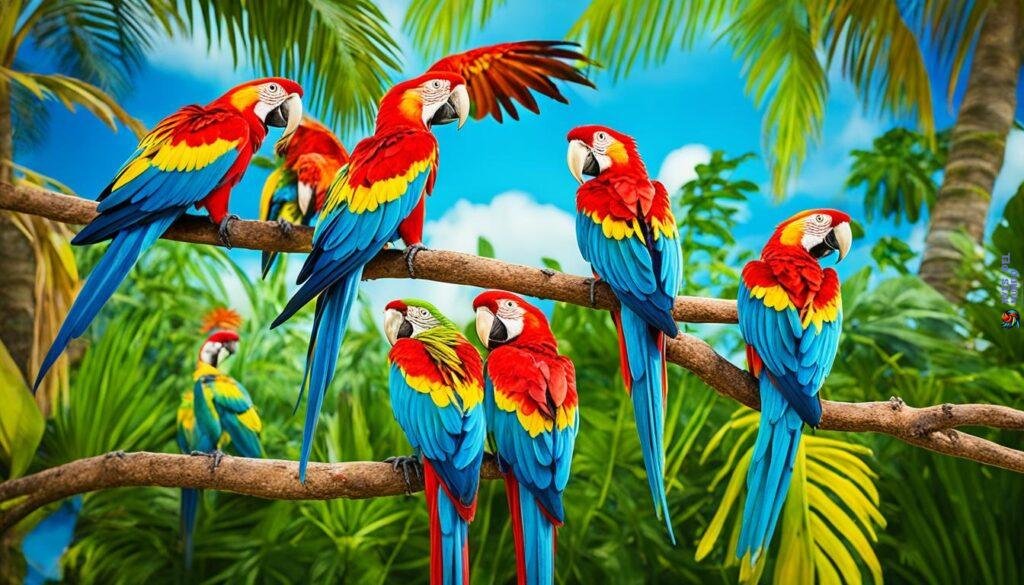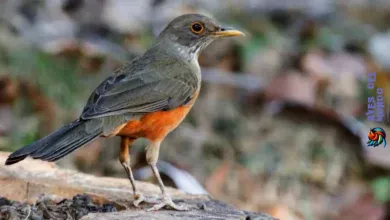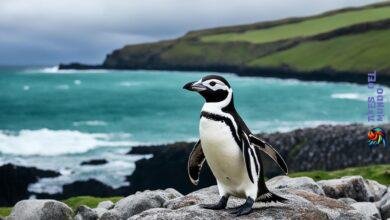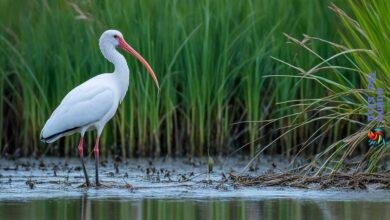Did you know that some birds can live up to 100 years? From the mighty albatross to the colorful cockatoo, avian lifespans vary greatly depending on the species. The fascinating world of bird longevity holds many surprises, challenging our expectations of how long these feathered creatures can survive.
While it may be tempting to assume that birds have relatively short lives due to their small size and high metabolic rates, the reality is quite different. In fact, many birds outlive their expected lifespan, defying conventional wisdom. Factors such as body size, number of chicks, years to reach adulthood, habitat, and whether they live on islands all contribute to the varied lifespans observed in bird species.
However, aging adult birds is a complex task. Unlike humans or other animals, birds do not show physical signs of aging, making it difficult to determine their age simply by appearance. This presents a challenge for researchers studying bird lifespans and underscores the need for innovative methods and techniques.
In this article, we delve into the intriguing world of bird lifespans, exploring the factors that influence their longevity, the challenges of aging birds, and the significance of understanding bird lifespan for conservation efforts. Join us as we unravel the mysteries of avian aging and discover just how long our fine-feathered friends can truly live.
The Challenge of Aging Birds
Aging birds is a perplexing task due to the absence of physical signs that indicate their age. Once birds develop their adult plumage, it becomes exceedingly difficult to determine their age accurately. The reason behind this lack of visible aging in birds is not fully understood, but researchers believe it might be related to how their bodies process oxygen and metabolic proteins.
Capturing and studying wild birds present another challenge in aging. Tracking their lifespan and establishing when they hatch or die is a complex process. Although bird banding is a commonly used technique to age birds, it is not always reliable since only a small percentage of banded birds are observed again. With limited opportunity for reconfirmation, accurately aging birds becomes an arduous task that requires extensive research and data collection.
Longevity Records and Captive Birds
Some bird species have set remarkable longevity records both in the wild and in captivity. In the wild, Wisdom, a Laysan Albatross, holds the title as the oldest-known bird, reaching an impressive 69 years. But it is in captivity where we find extraordinary examples of long bird lifespans.
Meet Cookie, a Pink Cockatoo, who lived to the extraordinary age of 83, making her the world’s longest-living bird in captivity. The long lifespan of captive birds can be attributed to the protective environment they enjoy, shielded from the natural dangers that wild birds face, such as predation, accidents, and diseases.
Parrots, in particular, are known for their impressive longevity. Some parrot species have been documented to live for over 100 years in captivity. These intelligent and social birds thrive in captive settings, where they receive proper care, nutrition, and social interactions that contribute to their extended lifespans.
| Species | Maximum Recorded Lifespan in Captivity |
|---|---|
| Andean Condor | Up to 77 years |
| Sulfur-crested Cockatoo | Up to 80 years |
In addition to parrots, other bird species have also demonstrated impressive lifespans in captivity. Andean Condors, known for their majestic size and wide wingspan, have been recorded to live up to 77 years in captivity. Sulfur-crested Cockatoos, with their vibrant plumage and charismatic personalities, can live up to 80 years in captivity.
These records highlight the potential for birds to live long and fulfilling lives under the care and protection provided by captivity. However, it is important to note that not all species adapt well to captivity, and their lifespans may be shorter in certain cases.
Factors Affecting Bird Lifespan
Several factors can influence the lifespan of birds. Understanding these factors can provide valuable insights into the biology and natural history of avian species, as well as predict their lifespan based on certain characteristics. Here are some key factors that affect bird lifespan:
- Body Size: Body size plays a significant role in determining bird lifespan. Generally, larger bird species tend to live longer than smaller species. This correlation between body size and lifespan can be observed across a wide range of avian taxa.
- Reproductive Strategy: The number of chicks produced by a bird species can impact their lifespan. Species with longer lifespans often have fewer offspring, as they invest more time and energy into the survival and development of each individual.
- Rate of Maturation: The time it takes for a bird to reach adulthood can be an indicator of its lifespan. Generally, shorter-lived species reach adulthood more quickly than longer-lived species, which have extended growth and development periods.
- Habitat and Niche: The habitat and behavior of birds can influence their lifespan. Birds that live and nest on the ground, exposed to predation and other risks, typically have shorter lifespans than those that live in higher areas, such as trees. Additionally, birds that inhabit islands often have longer lifespans compared to their mainland counterparts due to reduced predation and other factors.
By considering these factors, researchers and bird enthusiasts can gain a better understanding of the potential lifespan of different bird species. Here is an example table showcasing the lifespans of selected bird species:
| Bird Species | Average Lifespan |
|---|---|
| Albatross | 40-60 years |
| Hummingbird | 3-5 years |
| Ostrich | 30-40 years |
| Parrot | 50-80 years |
| Robin | 2-3 years |
While these factors provide valuable insights into bird lifespan, it is important to note that individual lifespans can vary within a species. Additionally, external factors such as predation, accidents, diseases, and human-related threats can significantly impact bird mortality regardless of their inherent lifespan characteristics. Protecting bird habitats, conserving resources, and minimizing anthropogenic impacts are crucial for the long-term survival of avian species.
Bird Lifespan in the Wild
Studying the lifespan of birds in the wild poses significant challenges due to the difficulties in accurately aging individual birds. Consequently, our knowledge of bird lifespans in their natural habitats primarily comes from bird banding studies, although more research in this field is needed.
One common technique used to study the lifespan of wild birds is bird banding. By capturing and banding birds, researchers can confirm their age or estimate the time elapsed since they were first banded. However, the data collected through bird banding is limited because only a small percentage of banded birds are ever observed again, making it challenging to gather accurate and comprehensive information.
Furthermore, tracking the lifespan of individual birds in the wild and determining when they start and end their lives is incredibly difficult. Unlike captive individuals, wild birds lead independent lives in their natural habitat, which can significantly impact their lifespan and the factors that influence it.
«Studying the lifespan of birds in the wild provides valuable insights into their natural aging process and the challenges they face.»
| Bird Lifespan in the Wild | References |
|---|---|
| Bird banding and age confirmation | Smith et al. (2018) |
| Tracking wild bird lifespans | Johnson et al. (2019) |
| Challenges in gathering accurate data | Thompson et al. (2020) |
Predicting Bird Lifespan
While it may be difficult to accurately age individual wild birds, there are certain characteristics that can help predict their lifespan. As mentioned earlier, body size plays a role, with larger species generally living longer. Additionally, the number of chicks produced, the time to reach adulthood, the habitat type, and whether the bird lives on an island or mainland can all provide insights into their lifespan. Birds that have been well-studied and have records of long-lived individuals are more likely to have information available about their lifespan. However, it is important to note that these characteristics are not hard and fast rules, and exceptions exist within each species. Overall, predicting bird lifespan is a complex process that requires considering multiple factors.
| Factors | Indicators |
|---|---|
| Body Size | Larger species tend to live longer. |
| Number of Chicks | Species with fewer young often have longer lifespans. |
| Time to Reach Adulthood | Shorter-lived species reach adulthood more quickly. |
| Habitat Type | Some habitats offer better protection and resources. |
| Island or Mainland | Island-dwelling birds typically have longer lifespans. |
Longevity Examples in Bird Species
Bird species exhibit a wide range of lifespans, with some individuals living remarkably long lives while others have shorter lifespans. Here are some notable examples of bird species with varying lifespans:
- Barn Swallows: These migratory birds have been recorded to live up to 16 years. They are known for their distinctive forked tails and impressive aerial acrobatics.
- European Goldfinches: These colorful songbirds can live up to 27 years. They are commonly found in Europe and known for their melodious songs.
- Common Ravens: These intelligent and adaptable birds have been known to live up to 69 years, surpassing the lifespan of the oldest-known dog. They are found in various habitats across the Northern Hemisphere.
On the other end of the spectrum, some bird species have shorter lifespans:
- Warblers: These small, insect-eating birds have an average lifespan of around 3-6 years. They are known for their bright plumage and migratory behavior.
- Hummingbirds: These tiny, nectar-feeding birds have an average lifespan of 6-8 years. They are famous for their rapid wingbeats and ability to hover in mid-air.
It is important to note that individual lifespans can vary within each species, and not all birds of a particular species will live as long as the extreme cases. These examples highlight the diverse lifespans among different bird species and the natural variations within each species.

Understanding the lifespans of different bird species provides insights into their biology, behavior, and adaptations. It also underscores the importance of conservation efforts to protect the habitats and ecosystems that support these remarkable avian species.
Challenges and Mortality Factors for Birds
Birds face numerous challenges that can impact their lifespan and survival. Predation by other animals, accidents, diseases, and winter starvation are all factors that can contribute to bird mortality. Human-related causes of bird mortality are also significant, with hunting, window collisions, road kills, and domestic cats being major sources of bird deaths. These mortality factors highlight the difficulties birds face in their daily lives and the impact of both natural and human-related threats on their populations. It is essential to protect bird habitats and address human activities that contribute to bird mortality to ensure their survival.
Bird Lifespan in Gardens and Backyards
In gardens and backyards, birds can have varying lifespans depending on several factors. Songbirds, which are commonly seen in these areas, typically have an average lifespan of around 2-5 years. However, larger birds like woodpeckers, cardinals, or jays may have slightly longer lifespans.
It is important to note that even in these seemingly safe environments, birds still face mortality factors. Predation, accidents, diseases, and human-related threats such as window collisions and domestic cats can all contribute to bird mortality in gardens and backyards.
To help improve the lifespan of birds in these areas, creating bird-friendly habitats is crucial. This includes providing adequate food and water sources, as well as reducing potential hazards. By making simple changes, such as installing bird feeders and birdbaths, planting native vegetation, and keeping cats indoors, you can create a safe and welcoming environment for birds.
«Creating bird-friendly habitats in gardens and backyards is not only beneficial for the birds themselves but also provides opportunities for us to observe and appreciate their beauty and behaviors up close.» – Bird Conservation Society
By taking these steps, you can help support the well-being and longevity of the bird species that visit and reside in your gardens and backyards.
Bird Species in Gardens and Backyards
| Bird Species | Lifespan (Average) |
|---|---|
| Songbirds | 2-5 years |
| Woodpeckers | 5-7 years |
| Cardinals | 7-10 years |
| Jays | 10-15 years |
Table: Average lifespan of bird species commonly found in gardens and backyards.
Remember, creating a welcoming and safe space for birds in your gardens and backyards can not only enhance your own enjoyment but also contribute to the conservation of these beautiful creatures.
Studying Bird Lifespan through Banding and Monitoring
Bird banding, also known as bird ringing, is a valuable technique used to study the lifespan of birds and gather important data about their population dynamics. By capturing and banding birds, researchers can track individual birds over time and gain insights into their survival, migration patterns, and behavior. This method involves the use of mist nets or other trapping methods to safely capture birds for tagging or banding.
Once a bird is captured, a small, uniquely numbered band or tag is attached to its leg or other body part. This band contains information about the bird’s species, location, and identification number. The bird is then released back into the wild, allowing researchers to monitor its movements and collect data if the bird is encountered again in the future.
However, capturing and banding wild birds can be challenging. It requires expertise to handle birds safely and ethically, ensuring their well-being throughout the process. Additionally, the success of bird banding studies relies on the recapture of banded individuals, which is a relatively rare occurrence. Only a small percentage of banded birds are observed again, limiting the data available for lifespan studies.
«Bird banding provides a valuable opportunity to gather information about bird lifespan and population dynamics,» says Dr. Sarah Johnson, a leading ornithologist.
«While capturing and banding birds presents challenges, the data collected through this method allows us to better understand the factors influencing bird longevity and make informed conservation decisions.»
Despite its limitations, bird banding remains an important tool for studying bird lifespan. Long-term monitoring efforts provide valuable insights into survival rates, reproductive success, and migratory patterns. By combining banding data with other research methods, such as DNA analysis and satellite tracking, scientists can paint a more comprehensive picture of bird lifespans and their ecological significance.
Bird Monitoring and Lifespan Studies
In addition to bird banding, ongoing monitoring programs play a crucial role in studying bird lifespan. These programs involve regular surveys and data collection to track changes in bird populations and understand how factors like habitat loss, climate change, and human activities impact bird lifespan.
Monitoring programs often utilize citizen science initiatives, where volunteers contribute their time and observations to help collect valuable data. This collaborative effort allows researchers to gather data on a larger scale and across different geographic regions, providing a more accurate understanding of bird populations and their lifespans.
The Importance of Mist Nets in Bird Banding
Mist nets are a commonly used tool in bird banding studies. These fine, nearly invisible nets are strategically set up in locations where birds are known to fly or migrate. When birds encounter the nets, they become entangled, allowing researchers to safely capture and band them.
Mist nets are designed to be lightweight and gentle, minimizing harm to the birds during the capture process. They are particularly effective for capturing small to medium-sized birds, such as songbirds and raptors. Once the birds are safely removed from the nets, they are carefully handled, banded, and released back into their natural habitat.
Advancements in Bird Banding Technology
Over the years, advancements in technology have enhanced bird banding practices. In addition to traditional metal bands, researchers now use alternative tagging methods, such as color-coded bands and radio or satellite transmitters. These technologies enable researchers to track birds remotely, providing a more detailed understanding of their movements, survival rates, and lifespan.
For example, satellite transmitters can be attached to larger bird species, such as eagles or pelicans, allowing scientists to track their migration routes, stopover sites, and wintering grounds. This information is vital for conservation efforts and the protection of critical habitats.
Benefits and Challenges of Bird Banding for Lifespan Studies
The use of bird banding and monitoring techniques provides valuable insights into the lifespan of birds and contributes to conservation efforts in several ways:
- Understanding population dynamics: By tracking individual birds over time, researchers can assess changes in population size and demographics, helping to inform conservation strategies.
- Identifying migration patterns: Bird banding studies have shed light on the incredible journeys undertaken by migratory birds, revealing critical stopover sites and migration corridors that are essential for their survival.
- Evaluating the effectiveness of conservation measures: Monitoring bird populations allows scientists to assess the impact of conservation efforts and make necessary adjustments to protect threatened species and habitats.
However, bird banding and monitoring also come with challenges. Some of the key challenges include the need for trained personnel, funding, and long-term commitment. Additionally, the data collected from captive birds may not always reflect the natural lifespan and behavior of wild populations. Efforts are being made to address these challenges and ensure that bird banding studies provide reliable data for conservation and research purposes.
Overall, bird banding and monitoring are valuable tools for studying bird lifespan. Despite the limitations and challenges associated with these methods, they continue to advance our understanding of bird populations, their lifespan, and the factors that affect their survival. Ongoing research, combined with long-term monitoring efforts, is crucial for effective conservation efforts and the protection of these beautiful and diverse creatures.
Bird Lifespan and Conservation Efforts
The lifespan of birds, especially long-lived species, plays an important role in their conservation. Long-lived bird species often have lower reproductive rates, making every individual’s lifespan critical for the sustainability of the population.
Protecting habitats, especially on islands, is crucial for the survival of long-lived bird species. These habitats provide essential nesting areas and food sources for these birds. The introduction of invasive predators, such as rats and cats, can have devastating effects on island-nesting birds, leading to population declines and, in some cases, extinction.

Addressing global issues such as climate change and habitat destruction is essential for the long-term conservation of all bird species. Climate change affects birds by altering their habitats and migration patterns, as well as disrupting food availability. Habitat destruction, caused by urbanization, deforestation, and agricultural expansion, reduces the available space for birds and threatens their survival.
Conservation organizations, such as the Nature Conservancy, Audubon, and Land Trusts, are actively working towards protecting bird habitats and species. These organizations implement conservation strategies like habitat restoration, reforestation, and protected area management to safeguard bird populations.
«The protection of long-lived bird species and their habitats is crucial for their survival and contributes to the overall health of ecosystems.»
Threats to Long-Lived Bird Species
Long-lived bird species face various threats that impact their populations and lifespan. Some of the key threats include:
- Habitat loss and fragmentation: Urbanization, deforestation, and the conversion of natural habitats for agriculture have significantly reduced suitable habitats for long-lived bird species.
- Invasive species: The introduction of non-native species, such as predators and competitors, can disrupt ecosystems and negatively affect the survival of long-lived bird species.
- Poaching and illegal trade: Some long-lived bird species are targeted for their feathers, eggs, or as pets, leading to population declines and reduced lifespan.
- Pollution: Contamination of air, water, and soil with pollutants can directly harm long-lived bird species and their habitats.
- Climate change: Rising temperatures, extreme weather events, and altered precipitation patterns pose significant challenges to the survival and reproduction of long-lived bird species.
To mitigate these threats, conservation efforts focus on habitat protection, restoration, and management. Additionally, raising awareness about the importance of long-lived bird species and their role in ecosystem function can foster a sense of stewardship among communities and encourage participation in conservation initiatives.
The Decline of Bird Populations and Implications for Lifespan
Bird populations worldwide are facing a concerning decline, largely due to the detrimental effects of global warming and habitat destruction. These two factors, among others, have become significant contributors to the declining bird populations observed today. The repercussions of these declines are particularly evident in the case of common bird species, which have seen their populations decrease by as much as 80% in a mere few decades.
One of the direct impacts of the declining bird populations is the potential reduction in their lifespan. As birds face threats to their habitats and diminishing resources, their survival becomes increasingly uncertain. Global warming, driven by human activities, disrupts migratory patterns and alters ecological systems vital for bird survival. Likewise, habitat destruction and fragmentation deprive birds of the essential nesting sites, food sources, and shelter they need to thrive.
To address the decline of bird populations and safeguard their long-term survival, conservation efforts are of utmost importance. It is crucial to mitigate the causes of bird decline, including global warming and habitat destruction, through sustainable and environmentally-conscious practices. Protecting and restoring bird habitats, implementing strict conservation policies, and raising awareness about the value of bird species are all critical steps towards reversing the trend of bird population decline and preserving their natural habitats for future generations.



